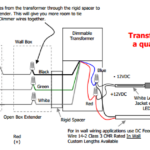At Inspired LED, we’ve been in the business long enough to have learned a thing or two about building and electrical codes. And over the years, we’ve seen some of the many creative ways that people have attempted to cut corners, or “hack” their lighting systems, using everything from soldering irons to spare lamp cords…
But before we get on to the big infractions, let’s start by reviewing the correct way to lay out a dimmable LED system.
Conventional Installs: Up to Code
Generally speaking, low voltage LEDs can be powered in one of two ways. The simplest set-ups utilize a low voltage plug-in power supply combined with a compatible “in-line” controller (usually a switch, dimmer, or remote). The benefit to these types of systems is the ease of install, which rarely requires the services of an electrician.
 The only disadvantage of these plug & play systems may be that these in-line switches and dimmers lack the perceived permanence and familiarity of a standard wall switch. For many lighting projects, this is not a problem. The LEDs look great, and in-line controls can often be mounted in a discrete location suitable for both convenience and functionality. But some customers prefer to be able to control their LEDs in the same way they control their other lights.
The only disadvantage of these plug & play systems may be that these in-line switches and dimmers lack the perceived permanence and familiarity of a standard wall switch. For many lighting projects, this is not a problem. The LEDs look great, and in-line controls can often be mounted in a discrete location suitable for both convenience and functionality. But some customers prefer to be able to control their LEDs in the same way they control their other lights.
If you’re OK with a non-dimmable lighting system and you have the ability to use or create a new switched outlet, problem solved! You can just plug in your power supply and turn it on or off as needed. But in order to be dimmed from a wall switch, an LED system must be powered using a hardwired dimmable transformer connected directly to the high voltage output of a compatible dimmer. Unlike plug-in power supplies, these types of transformers are designed to handle the 120V AC running through your power lines, converting them down to a more LED friendly voltage. While this type of system may be considered a bit more “finished” looking, and a bit more integrated into the home, it can also be quite a bit more expensive, especially after adding in the cost of hiring an electrician.
In general, follow the guidelines above when outlining your system, and you’ll have no trouble!
Of course, this is the real world. And given the constraints of each types of LED set-up, there are bound to be circumstances from time to time where sticking to these methods may prove a bit tricky, or may cost more than you’re willing to spend. This is when it can be tempting look for shortcuts, combining the look of a hardwired system with the convenience or financial savings of a plug-in power supply.
But beware, most if not all of these methods come at the cost of violating safety regulations. And even in the world of low-voltage this can pose a serious risk to the integrity of your system, and the safety of your home or business.
Shortcuts & Work-Arounds: NOT Up to Code
One of the most common workarounds we encounter is the creation of a “dimmable wall outlet”, a set up where a standard dimmer switch is connected directly to a wall outlet. While it may seem like a clever alternative, this installation technique can lead to a whole range of issues, not the least of which is a direct violation of National Electrical Code.
First of all, a standard plug-in power supply is not designed to be dimmed using high-voltage control. In this arrangement, the use of a wall dimmer simply causes irregular power fluctuations which dramatically shorten the life of the power supply, while inducing undesired behaviors such as blinking. Secondly, the “dimmable outlet” itself is prohibited by National Electrical Code Section 404.14E and 406.15. And for good reason. If a customer or future homeowner were to accidentally use this outlet for a standard appliance (blender, a vacuum, kitchen mixer, etc.) the dimming function is likely to cause severe damage to the device, and may even lead to fire.
Note: There are ways to create dedicated tamper-proof dimmable outlets for rare cases using products designed specifically for this purpose, like this one from Lutron. However, this is not a recommended method for LED installation or control. Be sure to consult a licenced electrician before considering this type of install.
 Another common work-around which we encounter from time to time is the “plug-in” hardwire transformer. Hardwire dimmable transformers are (as the name implies) designed to be hardwired into a building’s high voltage AC lines. This means turning off and splicing directly into the main power lines, bypassing any outlets entirely. While the internal components of a hardwire dimmable transformer can technically handle the high-voltage fluctuations coming from a standard power receptacle, it still leaves you with the “dimmable outlet” which remains in violation of electrical code, and presents a risk of fire.
Another common work-around which we encounter from time to time is the “plug-in” hardwire transformer. Hardwire dimmable transformers are (as the name implies) designed to be hardwired into a building’s high voltage AC lines. This means turning off and splicing directly into the main power lines, bypassing any outlets entirely. While the internal components of a hardwire dimmable transformer can technically handle the high-voltage fluctuations coming from a standard power receptacle, it still leaves you with the “dimmable outlet” which remains in violation of electrical code, and presents a risk of fire.
Note: There are certain types of specialty power supplies which can be either direct wired, or plugged into an outlet, but as of this date these are not a part of Inspired LED’s regular product inventory. We may, however, be able to source specialty power sources for your specific project when you work with one of our Lighting Designers to get a free layout and quote.
There are, of course, other ways of violating N.E.C., (none of which are recommended, which is why we won’t be delving into them further). As with any project, be sure to read up on relevant local and national codes before getting started. A complete copy of the National Fire Protection Association’s 2017 National Electrical Code can be found here.
Inspired LED Alternatives: Up to Code!
So what are you to do as a homeowner with unique power requirements, or a contractor with extreme budgetary restrictions? Does this mean you’ll have to chose between scrapping your project, or hiding your light system from the building inspector? Not at all! Inspired LED is here to help, and in the past few years we’ve specifically developed some of our own unique products to serve as clever alternatives in these types of cases. And the best part is, they’re 100% up to code!
 Inspired LED’s patented TRIAC Analyzer was specifically designed for those applications when using a pulg-in power supply is the only option , but the customer still wants to be able to use a wall-dimmer switch for control. As mentioned above, typically, these types of power supplies are not designed to be dimmed on the high voltage side, and wiring a dimmer switch directly to an outlet is against code. But last year our Engineering Team took up the challenge, and cleverly devised a way to transform standard high-voltage dimmer switches into low-voltage compatible controllers using a single device.
Inspired LED’s patented TRIAC Analyzer was specifically designed for those applications when using a pulg-in power supply is the only option , but the customer still wants to be able to use a wall-dimmer switch for control. As mentioned above, typically, these types of power supplies are not designed to be dimmed on the high voltage side, and wiring a dimmer switch directly to an outlet is against code. But last year our Engineering Team took up the challenge, and cleverly devised a way to transform standard high-voltage dimmer switches into low-voltage compatible controllers using a single device.
A standard non-dimmable power-supply is wired back to the TRIAC Analyzer together with your desired switch and selected LED lights. The Analyzer reads the state of the dimmer, adapting to its particular range, and passes on the signal to the LEDs. This solution is especially useful when completing retrofit installations where the style of the switch is important, but the electrician does not have access to the main wiring. Sound like the solution for you? Read more about the TRIAC Analayzer here, or visit our product page for specifications and additional information.
Our most technically advanced alternative to the traditional hardwire or plug-in power options is the Wireless Independence Dimmer System. If your primary concern is ease of install, and you’re happy with a simple flat paddle style switch, this is the way to go! Like the TRIAC Analyzer, this product allows you to achieve the look of a wall dimmer switch using a plug-in power supply, however the wireless functionality of this specialized switch also means that the system is entirely plug & play–no in-wall wiring required!
Energy-harvesting technology allows the kinetic force of each click to be harnessed, and sent as a remote signal to the dimmable receiver, located between your power supply and your LED lights. This means the switch is free to be mounted pretty much anywhere within 30 meters, or kept as a portable remote, (hence the name “Independence Dimmer”).
A single Independence Dimmer Switch can be paired with a dozen different receivers for a truly versatile set-up, and dual-switch models are also available for zoned control. While the cost may be a bit higher upfront, this product will certainly save money when compared to the expense of in-wall wiring and drywall repair! Learn more about Inspired LED’s Wireless Independence Dimmer on our product page, or contact our Design Team to find out whether this system may work for you.
No matter where you’re planning to install your next batch of LED lighting, take the time to make sure your system is up to code. What may at first seem like a convenient short-cut will likely end up costing you additional time and money for replacements or repairs. And most importantly, no amount of time or money saved is worth the risk of compromised safety. So know your codes, do your research, and when in doubt don’t be afraid to ask an expert!
Inspired LED is committed to providing our customers with safe, energy-efficient products and reliable services. For assistance with your next LED system, take advantage of Inspired LED’s FREE Design Services. Work with an expert Lighting Designer to determine the best products and optimal layout for your application, as well as receive technical support during and after installation. Or, for further assistance, contact our Customer Service team at orders@inspiredled.com, or by phone at 480-941-4286.







